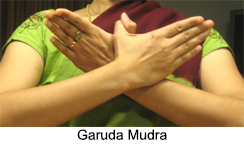 Garuda Mudra is one of the mudras that is exercised for alleviation of some diseases or internal troubles. Exercising Garuda Mudra activates the blood flow and the circulation. It also helps to alleviate exhaustion. For best result, this mudra should be practiced three times a day for four minutes.
Garuda Mudra is one of the mudras that is exercised for alleviation of some diseases or internal troubles. Exercising Garuda Mudra activates the blood flow and the circulation. It also helps to alleviate exhaustion. For best result, this mudra should be practiced three times a day for four minutes.
Meaning of Garuda Mudra
Garuda is the emperor of the birds in sky and is the challenger of snakes. It is a powerful mythological bird on which Lord Vishnu travels. Garuda Mudra is used to balance the air energy in the body which creates encouragement and it strengthens the human being. The word "Garuda" means "eagle" in Sanskrit and mudra means, "sign of". By activating blood flow, the Garuda Mudra stimulates and balances the air energy on the body.
Steps of Garuda Mudra
To perform Garuda Mudra, there are certain steps which are needed and these are as follows:
At first, clutch the thumbs and place the hands, right hand on top of the left hand on the lower stomach. Stay on in this pose for about 10 breaths and then slide the hands up to the navel. Stay on there for another ten breaths.
•After that, place the hands on the pit of the stomach and stay again for about ten breaths. It is recommended to do this Garuda mudra three times a day for four minutes.
•After this, left hand is placed on the sternum, and hands are turned in the direction of the shoulders and the fingers are kept spread.
Benefits of Garuda Mudra
Garuda Mudra activates the blood flow and circulation. It energizes the organs, and balances energy on both sides of the body. Whether in the pelvic or chest area, it stimulates and rouses the body. It settles down and reduces pain related menstrual complaints, stomach related diseases, and respiratory difficulties. It also helps an individual to deal with exhaustion and mood instabilities.
This article is a stub. You can enrich by adding more information to it. Send your Write Up to content@indianetzone.com.




















